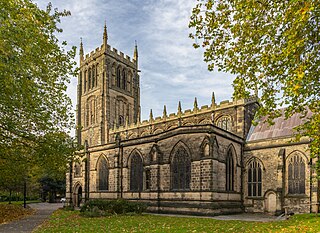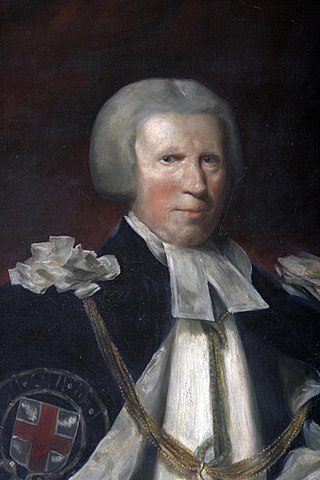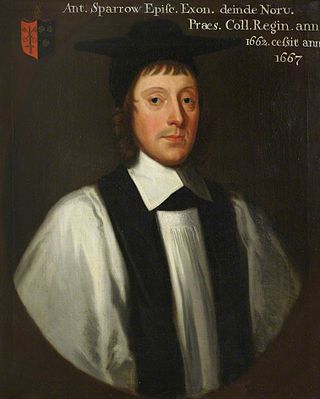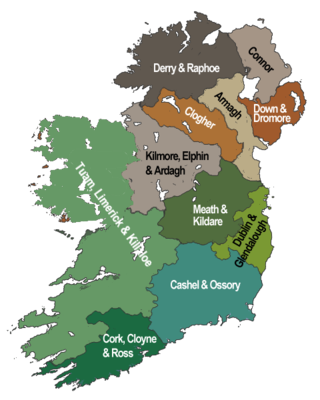This article needs additional citations for verification .(February 2019) |
James Bickham (1719-1785) was a fellow of Emmanuel College, Cambridge, and clergyman, scholar and fifteenth archdeacon of Leicester.
This article needs additional citations for verification .(February 2019) |
James Bickham (1719-1785) was a fellow of Emmanuel College, Cambridge, and clergyman, scholar and fifteenth archdeacon of Leicester.
James Bickham was born in Evercreech, Somerset, the son of James Bickham. He was educated at Sherborne, and Emmanuel College, Cambridge, where he obtained a BA in 1741, a Fellowship in 1743, MA in 1744, BD in 1751 and DD in 1774. [1]
Bickham was admitted to the diaconate by Richard Reynolds, Bishop of Lincoln, at Lincoln Cathedral in 1744, and admitted to priesthood by Thomas Gooch, Bishop of Norwich, in Norwich Cathedral in 1745. He was presented the rectory of Loughborough by his college in 1761, the benefice income of which had been trebled by enclosure awards.
In 1772 Bickham was collated to the archdeaconry by his diocesan John Green, becoming the fifteenth Archdeacon of Leicester. As an archdeacon in the third largest of the six archdeaconries in the vast Lincoln diocese, Dr Bickham played an important role in preserving the fabric of its churches and church buildings. In 18th century England there was considerable concern about the steady decay of church buildings, with ecclesiastical figures such as Bishop Fleetwood and Archbishop Secker predicting that unless more was done to maintain the fabric of churches and the houses of clergy, England would lose many of them in the ensuing century. With the responsibility for the maintenance of churches fell in large part upon parishioners, and of the parsonages on the residing clergy, it was not always easy to persuade those with small incomes to undertake the necessary repairs. [2]
By the 18th century the once powerful archdeacons' courts had been eclipsed, and so whether any action was taken to preserve church buildings depended in large part upon the personal interest and ability of individual archdeacons. Dr Bickham responded enthusiastically to the challenge, and between 1773 and 1779 undertook a great many personal inspections, including 123 parsonage houses, and encouraged clergy and parishioners to undertake necessary remedial work. By great chance, the records of his personal visitations are preserved in the Leicester archdeaconry and today form an important historical source. [3]
Bickham died in 1785 and left a valuable library to the rectory of Loughborough.R [4]

In the Roman Catholic Church and the Anglican Communion as well as some Lutheran denominations, a rural dean is a member of clergy who presides over a "rural deanery" ; "ruridecanal" is the corresponding adjective. In some Church of England dioceses rural deans have been formally renamed as area deans.


Sir George Pretyman Tomline, 5th Baronet was an English clergyman, theologian, Bishop of Lincoln and then Bishop of Winchester, and confidant of William Pitt the Younger. He was an opponent of Catholic emancipation.

Anthony Sparrow (1612–1685) was an English Anglican priest. He was Bishop of Norwich and Bishop of Exeter.
The Archdeacon of Oxford is a senior ecclesiastical officer in the Diocese of Oxford, England. The office responsibility includes the care of clergy and church buildings within the area of the Archdeaconry of Oxford.
The Archdeacon of Leicester is a senior ecclesiastical officer in the Church of England Diocese of Leicester.
Reynold Gideon Bouyer was an English clergyman, archdeacon of Northumberland.
Henry Vincent Bayley (1777–1844) was an English clergyman. Of the High Church party and a reformer, he became Archdeacon of Stow. He associated with the Hackney Phalanx group of High Church activists.
Charles Daubeny (1745–1827) was an English churchman and controversialist, who became archdeacon of Salisbury.
John Walker D.D. was an English churchman, archdeacon of Essex from 1571.
George Gardiner (1535?–1589) was an English churchman, Dean of Norwich from 1573.
Henry Kaye Bonney D.D. was an English churchman, photographer and author.
The Archdeacon of Sherborne is a senior ecclesiastical officer within the Diocese of Salisbury, England. He or she is responsible for the disciplinary supervision of the clergy within the five area deaneries: Dorchester, Lyme Bay, Sherborne, Weymouth and Portland, and Blackmore Vale.
William Dodwell (1709–1785) was an English cleric known as a theological writer, archdeacon of Berkshire from 1763.
The Archdeacon of Loughborough is a senior ecclesiastical officer within the Diocese of Leicester. The archdeaconry was created within the Diocese of Peterborough and from the Archdeaconry of Leicester on 25 February 1921 but became part of the new Diocese of Leicester upon its creation on 12 November 1926.

The Archdeacon of Cloyne was a senior ecclesiastical officer within the Diocese of Cloyne until 1835; and then within the Diocese of Cork, Cloyne and Ross until 1986 when it merged with the Archdeaconry of Cork. As such he was responsible for the disciplinary supervision of the clergy within the Cloyne Diocese.

The Archdeacon of Ossory was a senior ecclesiastical officer within the Diocese of Ossory until 1835 and then within the Bishop of Ossory, Ferns and Leighlin until 1977 when it was further enlarged to become the Diocese of Cashel and Ossory. As such he was responsible for the disciplinary supervision of the clergy within the Cloyne Diocese.

The Archdeacon of Kells, alias the Archdeacon of Nobber, was a medieval ecclesiastical post in the Diocese of Meath in the Kingdom of Meath, Ireland. The archdeaconry was officially established sometime between the 11th and 13th centuries, and was annexed to the Rectory of Nobber. In the 16th century, the office was briefly united to the Bishopric of Meath, but afterwards separated again. As a consequence of the Reformation, the Archbishop of Armagh held the "Archdeacony of Kells, in commendam 1569 to 1584". Sometime before 1622, the Archdeacon of Kells and Rectory of Nobber were permanently united to the bishopric of Meath.

The Archdeacon of Dromore is a senior ecclesiastical officer within the Anglican Diocese of Down and Dromore. The Archdeacon is responsible for the disciplinary supervision of clergy within the Diocese.